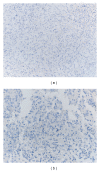Brachyury: a diagnostic marker for the differential diagnosis of chordoma and hemangioblastoma versus neoplastic histological mimickers
- PMID: 24591762
- PMCID: PMC3925620
- DOI: 10.1155/2014/514753
Brachyury: a diagnostic marker for the differential diagnosis of chordoma and hemangioblastoma versus neoplastic histological mimickers
Abstract
Brachyury is a transcription factor which is required for posterior mesoderm formation and differentiation as well as for notochord development during embryogenesis. Due to its expression in the neoplastic cells of chordoma, a malignant tumour deriving from notochordal remnants, but not in tumors showing a similar histology, brachyury has been proposed as a diagnostic marker of this neoplasia. Though commonly considered a hallmark of chordoma, the expression of brachyury has been also documented in the stromal cells of hemangioblastoma (HBL), a slow growing tumor which may involve the central nervous system (CNS) and, rarely, the kidney. Herein we review the role of brachyury immunohistochemical detection in the identification and differential diagnosis of chordoma and HBL towards histological mimickers and suggest that brachyury is added to the panel of immunohistochemical markers for the recognition of HBL in routinary practice, principally in unusual sites.
Figures



References
-
- Herrmann BG. Expression pattern of the Brachyury gene in whole-mount T(Wis)/T(Wis) mutant embryos. Development. 1991;113(3):913–917. - PubMed
-
- Kispert A, Herrmann BG. Immunohistochemical analysis of the Brachyury protein in wild-type and mutant mouse embryos. Developmental Biology. 1994;161(1):179–193. - PubMed
-
- Vujovic S, Henderson S, Presneau N, et al. Brachyury, a crucial regulator of notochordal development, is a novel biomarker for chordomas. Journal of Pathology. 2006;209(2):157–165. - PubMed
-
- Salisbury JR. The pathology of the notochord: review article. The Journal of Pathology. 1993;171:153–155. - PubMed
Publication types
MeSH terms
Substances
LinkOut - more resources
Full Text Sources
Other Literature Sources
Medical
Research Materials

